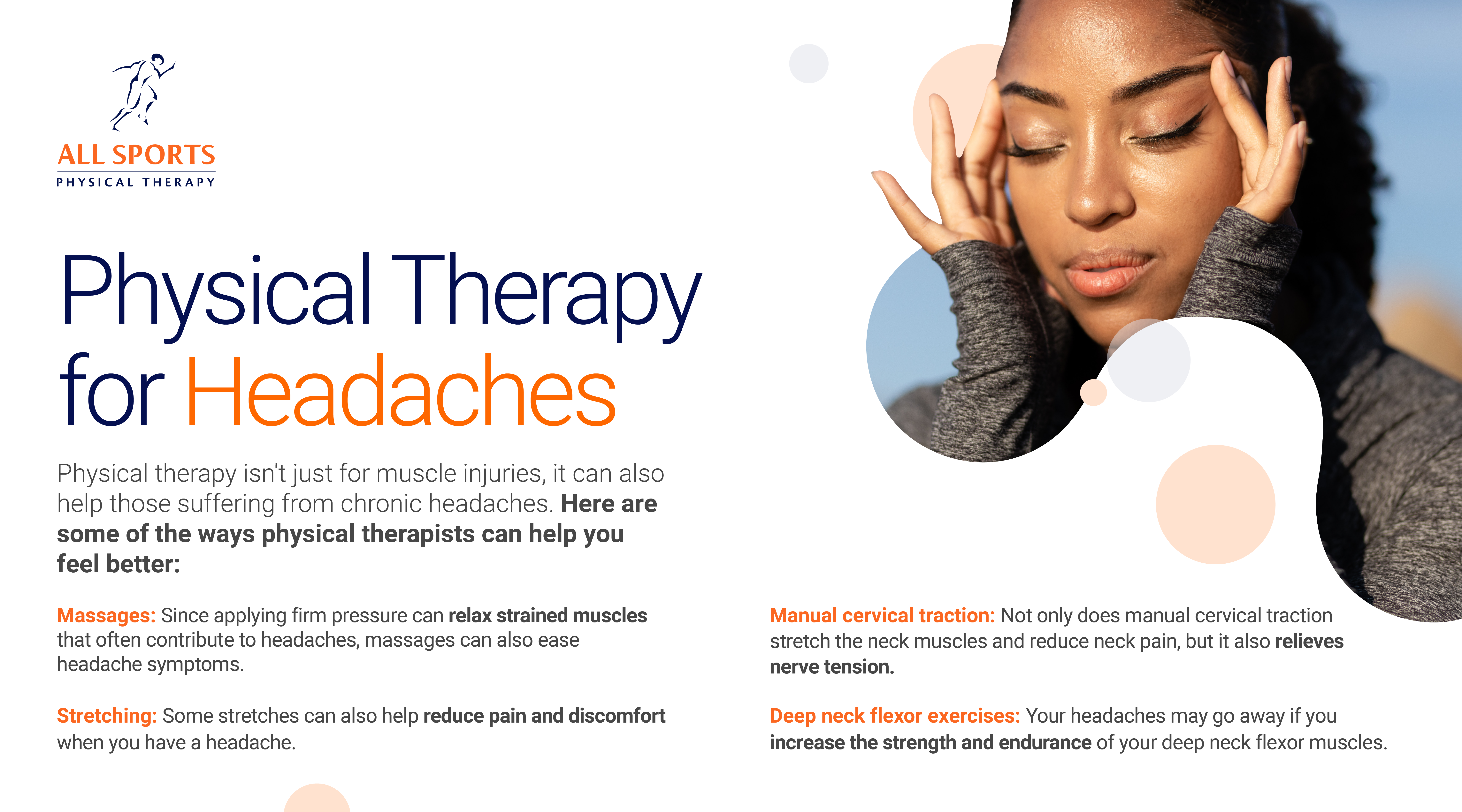Physical Therapy for Headaches? It’s More Common than You May Think
Physical Rehabilitation

When it comes to getting rid of headaches, you’ve probably heard all about using hot compresses or taking Tylenol, but what about physical therapy?
Headaches can be, well, a headache. Not only are they uncomfortable and potentially painful, but they can also significantly disrupt your lifestyle, preventing you from giving your 100% at work or home. After all, lightheadedness, dizziness, nausea, muscle tenderness, neck pain, and nerve irritation are all often associated with headaches.
It’s no surprise, then, that people try all sorts of things to get rid of their headaches, from essential oils, to acupuncture, to botox. Others turn to hot or cold compresses or over-the-counter medications like Tylenol and Advil for relief. However, there’s another simple headache solution: physical therapy. It may seem surprising, but PT is a common — and effective — treatment method for chronic headaches that patients are increasingly turning to.
How a physical therapist can help your headache
When you think of reasons to go to a physical therapist, you probably think of back pain, post-injury or post-surgery rehabilitation, or arthritis. While it may not be as top of mind as those circumstances, headaches are another common reason for people to seek physical therapy.
If you visit a physical therapist, they can determine which type of headache you have by conducting a comprehensive musculoskeletal exam that assesses your joint mobility, range of motion, and musculature tightness before recommending a treatment plan designed to target the specific causes of your pain. These causes can vary based on the type of headache you’re experiencing. For example, tension headaches usually occur when your neck and scalp muscles tense or contract, often in response to depression, anxiety, stress, or a head injury. On the other hand, you might experience cervicogenic headaches, migraines, or headaches caused by an underlying condition like a sinus disorder, fever, or tumor, all of which have their own separate causes.
Instead of simply providing a temporary solution like painkillers do, your physical therapist can discover and address the underlying problem, providing more lasting relief and helping prevent future headaches. For example, your physical therapist might find that your sleeping and eating habits are worsening your headaches’ intensity and frequency and tell you which habits to avoid. Plus, the right physical therapist can help improve your mobility, range of motion, back and shoulder muscle strength, and overall quality of life, providing even more relief than just a reduction in headache pain.
Physical therapy techniques for headaches
While over-the-counter medications help block pain, physical therapy targets your muscles and joints to stop some headaches at their source. Physical therapy can help treat migraine-related musculoskeletal problems and reduce symptoms like dizziness, loss of balance, and vertigo. But that’s not all physical therapy is good for. Your physical therapist can also help you improve your posture, maximize movement, and manage everything from vascular conditions to aging.

Common techniques your physical therapist may use include:
- Massages: Massages aren’t just great for relaxation. Since applying firm pressure can relax strained muscles that often contribute to headaches, massages can also ease headache symptoms. Plus, once your therapist discovers which massage does the trick, they can teach you or your loved ones how to do it at home.
- Stretching: Some stretches can also help reduce pain and discomfort when you have a headache. When you attend physical therapy, your therapist can walk you through stretches that target areas responsible for your headache.
- Manual cervical traction: Manual cervical traction is a tried and true method that physical therapists use to help separate your neck’s bones, joints, and disks. Not only does this stretch the neck muscles and reduce neck pain, but it also relieves nerve tension.
- Deep neck flexor exercises: Located on the side of the front of the neck, weak deep neck flexors have been associated with headaches. However, your headaches may go away if you increase the strength and endurance of your deep neck flexor muscles.
Of course, everyone is different — and physical therapy and exercise can sometimes worsen symptoms if they aren’t implemented correctly. That’s why you need to work with an experienced physical therapist!
Get rid of headaches quickly with help from All Sports!
Headaches can put a damper on your quality of life, but you don’t have to suffer in silence or with temporary home remedies. Physical therapy can make a world of difference for people who suffer from headaches!
Ready to see an experienced physical therapist and say goodbye to headaches? Work with a therapist at All Sports Physical Therapy, New York’s premier physical therapy practice. Schedule an appointment today!



